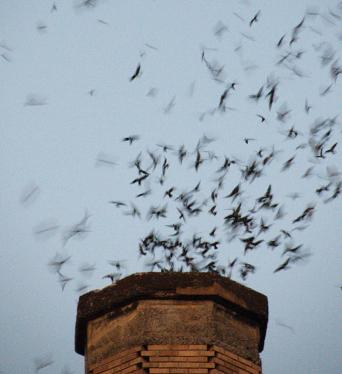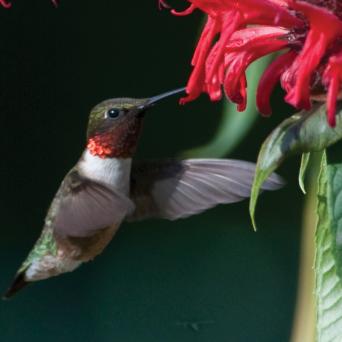
These Winged Summer Visitors Are Fast, So See Them While You Can
Two unique birds honor us with their presence for a few months each summer — the chimney swift and the hummingbird.
Chimney swifts, swallows and hummingbirds are all related. They all have long wings containing short bones that allow for some spectacular flying and hovering. The tiny chimney swift winters in South America and shows up in early April, while the ruby-throated hummingbird, the only hummer who comes to our area, winters in Mexico and arrives in late April or early May.
The chimney swift is one of the fastest fliers of the bird world, flying at up to 69 miles per hour. (Peregrine falcons have been clocked faster, but only in a stooping dive.)
Chimney swifts are often referred to as “flying cigars” because their bodies appear straight and uniformly black from a distance. They have short, deeply forked tails with very long, swept-back, tapered wings resembling a boomerang. Their scientific name (Apus apus) means “without feet,” because they have very short legs that are used only for clinging to vertical surfaces with their sharp toes. These birds never settle on the ground voluntarily.
Chimney swifts are environmentally beneficial because of their voracious appetite for bugs, but their populations are declining dramatically, along with other insectivore bird species. Some scientists believe that their decline is due less to habitat loss than to the reduction of their food sources from pesticide spraying or from global warming causing insect populations to peak at the wrong times.
Chimney swifts drink, feed, often mate and sleep on the wing. They are among the most aerial of birds, flying almost constantly except when they nest or roost at night. The chimney swift even bathes in flight, gliding down to water, smacking the surface with its breast, then bouncing up and shaking the water from its plumage as it flies away.
Chimney swifts tend to fly in “screaming parties” on summer evenings, in which 10 to 15 birds fly high and in circles, calling to each other. They are confused with bats because their flight is so erratic and because they are active until dusk. If you aren’t sure if you are seeing a bat or a bird, just listen — bats are silent fliers.
Before the settlement of North America, the chimney swift likely nested in caves and hollow trees. Today they will build their nests in buildings, under window sills, in chimneys and in smokestacks. Unfortunately, changes in chimney design, with covered caps, narrow flues and metal liners, have decreased their available nest sites. However, artificial “chimney swift towers” are being successfully constructed and installed throughout the country.
Only one pair nests in a single chimney, in a half saucer of woven small twigs held together and stuck to a vertical surface by their sticky saliva. But in non-breeding season, large numbers of chimney swifts will roost together.
In the fall, they participate in spectacular “swarming” behavior in which many, sometimes hundreds or thousands, gather at dusk at selected chimneys and circle above the opening before they all drop down into the roost almost as one. It is a magical sight that is occurring less and less as large chimneys and smokestacks disappear.
The ruby-throated hummingbird, a/k/a the flying jeweled paper clip (they weigh as much as a paper clip), are chimney swifts’ cousins. They come to our area to breed, but finding a hummingbird nest is almost impossible. The diameter of the nest is the size of a quarter, and two eggs would only cover half a penny. The nest is constructed of plant down and bud scales, covered with lichens, bound with spider’s silk and placed on a small horizontal limb, 10-20 feet high, preferably over or close to water. Ironically, hummers can get easily tangled in spiders’ webs and perish.
The male hummer has an iridescent red throat that may also appear black depending on the light. The female has iridescent green upper parts with whitish and unmarked underparts. They eat flower nectar, small insects, spiders and sap from sapsucker-drilled holes. They can be enticed by backyard feeders containing sugar water, but they cannot live on nectar alone.
Hummingbirds have fast metabolisms and must feed about every 10 minutes. At night, and in periods of cold or stress, they slow their metabolism to conserve energy. During these periods of torpor, the heartbeat slows from as many as 1,260 beats per minutes to only 50. There are periods when the bird does not breathe, is stiff and numb and, to all appearances, is dead. It can remain like this overnight and for most of a day.
Planting nectar-rich flowers that attract hummingbirds and providing them sugar water in specially designed feeders go hand in hand. Be aware that if you decide to set out a hummingbird feeder, you must keep it clean. Keep the feeder up until the end of September, when hummers gorge themselves to fuel up for their nonstop 600-mile crossing of the Gulf of Mexico.
Use a sugar solution of 1 cup sugar to 4 cups water. (A higher sugar concentration can cause liver disease). Do not boil it, but warm the water to almost boiling. Keep it refrigerated until you use it.
The enjoyment I get all summer long watching swifts and hummers is priceless. And I like to envision the little jeweled paper clips flying over the Gulf of Mexico using some fat reserves from my yard.
Bat expert, wildlife rehabilitator and Weavers Way member Brenda Malinics runs Brenda’s Cat Rescue (www.brendascatrescue.org). Reach her at bmalinics@gmail.com.

